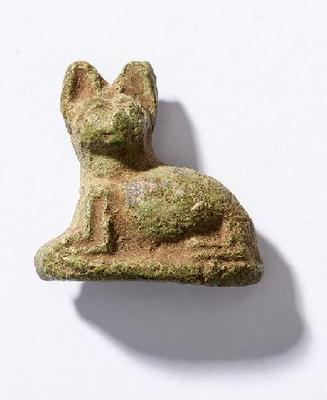Animorph, seated cat
Production date
Early 20th Century CE
Country
Egypt
See full details
Object detail
Description
An Egyptian amulet in the form of a cat. Fabric is olive green with areas of brown. Possibly applied to suggest faience. Cat is seated, with rounded ears, thin legs, prominent body and tail wrapped around the body. The back is slightly faceted where the amulet has been pressed into the mould and there is evidence of fingerprints. Tool marks are present on the reverse, probably made during manufacture. This set of 8 amuletic animorphs (cats) may represent jackals (the god Anubis) cats (the goddess Bastet). All have threading hole through neck. Likely strung on a necklace or bracelet.
Classification
ARCHAEOLOGY Egyptian figure
Production date
Early 20th Century CE
Production place
Measurements
H21mm x W20mm x D9mm
Media/Materials description
Pottery
Glaze
Glaze
History and use
In the First World War, many servicemen saw duty in foreign lands, collecting ancient items of material culture and sending these back to loved ones back home.
For the amateur soldier-archaeologist there were many opportunities to secure Egyptian antiquities. A short horse ride with a local guide to a rich gravesite, would secure a dozen scarabs after a few minutes of digging. Curios could be purchased from street sellers, authentic antiquities dug up from the desert sands, or faux objects ‘inspired’ by authentic pieces, such as large scarab paperweights.
Selling replicas as genuine antiquities has been big-business in Egypt for hundreds of years. At the start of the war the trade in Egyptian fake antiquities was large, and proved a decent money earner for street sellers in Egypt. The number of soldiers travelling through or training in Egypt would have been an absolute boon for the souvenir sellers, including those selling ‘genuine’ antiquities and faux objects ‘inspired’ by the genuine antiquities, such as this object.
For the amateur soldier-archaeologist there were many opportunities to secure Egyptian antiquities. A short horse ride with a local guide to a rich gravesite, would secure a dozen scarabs after a few minutes of digging. Curios could be purchased from street sellers, authentic antiquities dug up from the desert sands, or faux objects ‘inspired’ by authentic pieces, such as large scarab paperweights.
Selling replicas as genuine antiquities has been big-business in Egypt for hundreds of years. At the start of the war the trade in Egyptian fake antiquities was large, and proved a decent money earner for street sellers in Egypt. The number of soldiers travelling through or training in Egypt would have been an absolute boon for the souvenir sellers, including those selling ‘genuine’ antiquities and faux objects ‘inspired’ by the genuine antiquities, such as this object.
Associated person
Registration number
H14423.3



